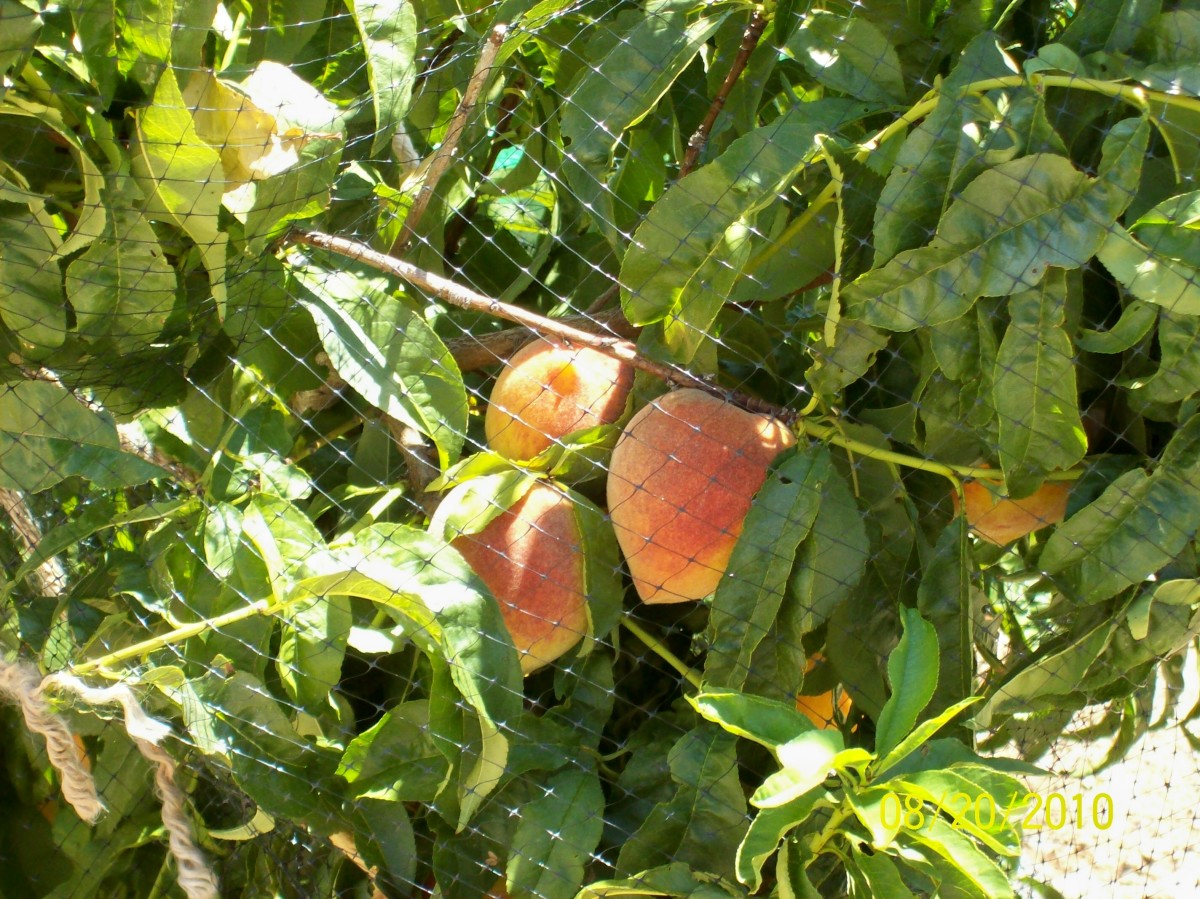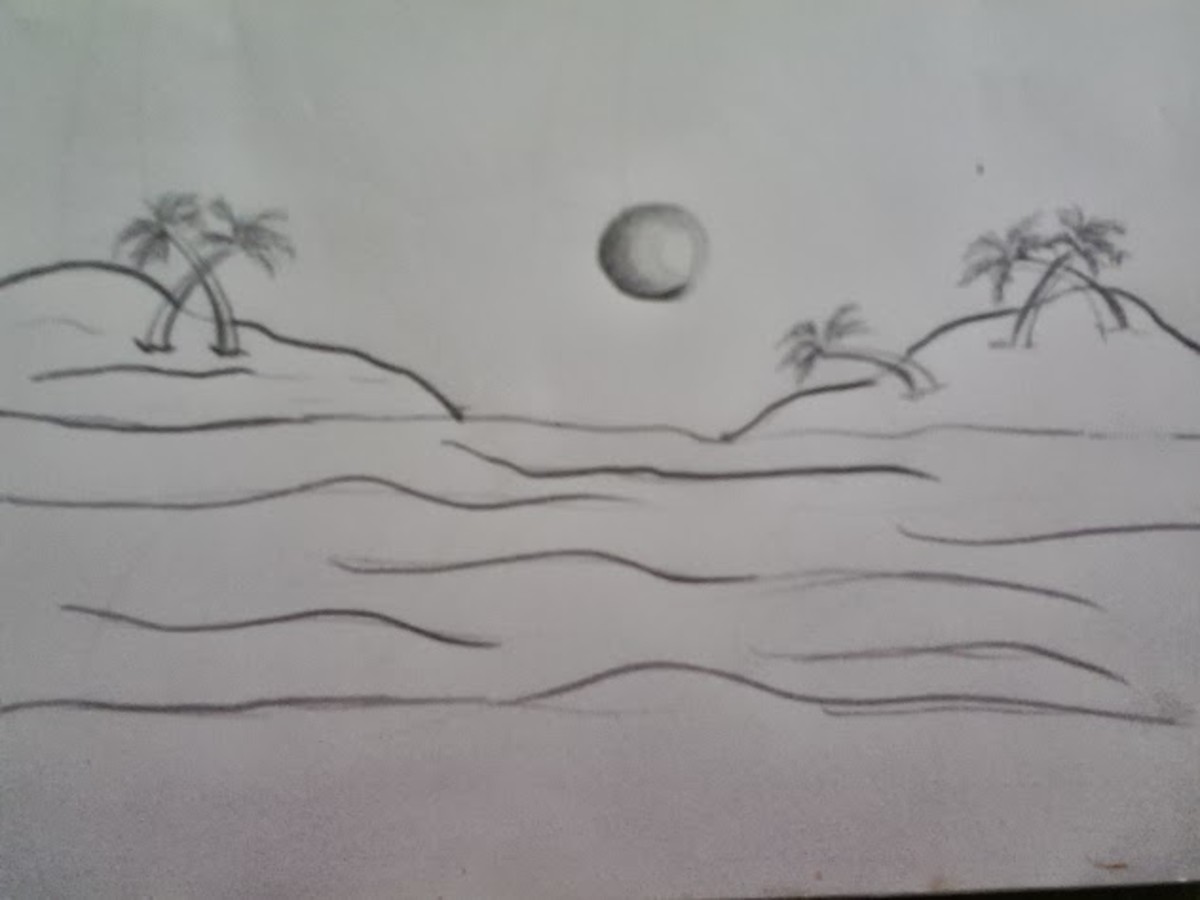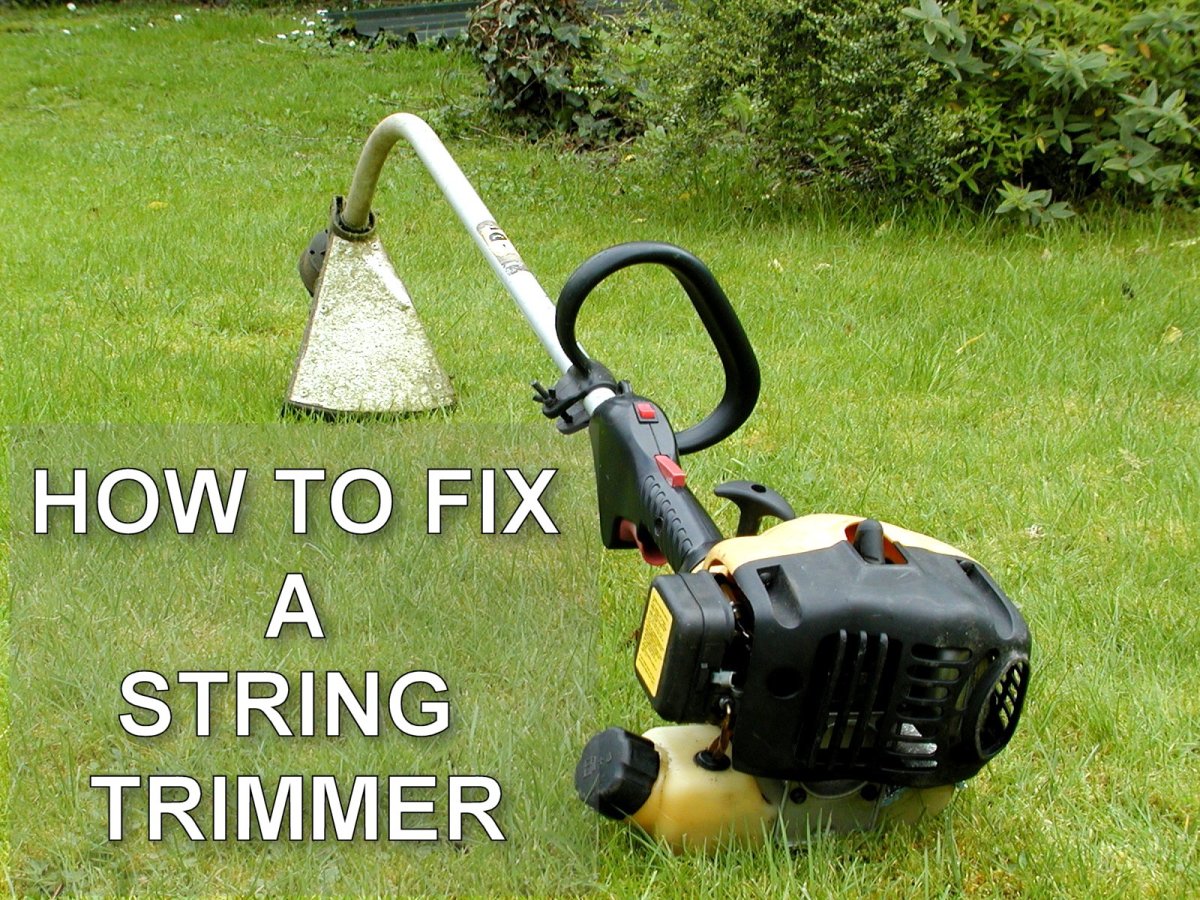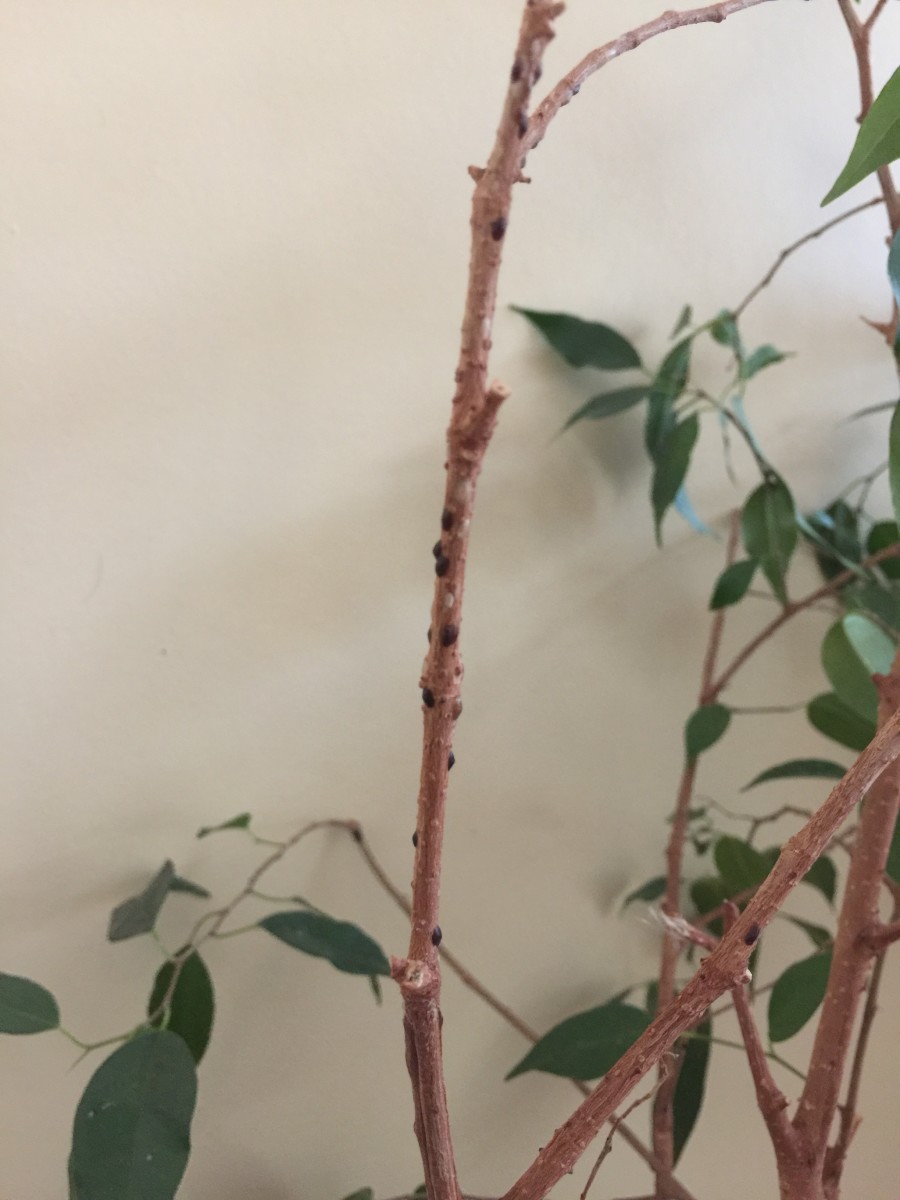- HubPages»
- Home and Garden»
- Gardening»
- House Plants
Tasmania: Living in the House that Doesn't Exist, Starting the vineyard! OMG (4)
Meeting our forester neighbour: Who helps us heaps.
After Living in the House that Doesn't exist Rod and I venture forth and explore our property.
The next neighbour Rod and I met was down the slope at the front of our property. Hidden behind hectares of blackberries that stretched high and wide all the way along our front boundary we discovered a small track. We scraped our way through and broke through to a rotting fence. This fence was still covered in blackberries but some of the blackberries had been cut back, and some of the rotting fence between our boundaries, had been replaced. From this point, we could see a shipping container and caravan with a solid annexe, sporting windows and a smoking chimney in another neighbour's yard.
This shed/house was surrounded by tons of old horse shoes, old stoves, metal roofing, long bits of scrap iron, pipe, piles of stuff in boxes, some old cars and more metal. Several dogs barked at our approach to the fence line. One dog looked like a pit-bull, and worse, there was another more horrible Hound of the Baskerville’s! This second dog was enormous and black. It had the head of a lion. It slobbered. It barked furiously at us and lunged towards the fence. Rod and I were about to run for our lives, when, from behind the blackberries popped a round jolly faced, red-haired man with his hand outstretched and a welcoming smile. ‘Don’t worry about the dogs. They stay inside the wire,’ he told us, with an audible Irish accent. ‘I’m Arl. Those dogs are me mates and they’re friendly. That one’s called Tiny, for obvious reasons.’ He pointed to the hideous hound. ‘The other one’s Silver. Come over the fence. Have a cuppa.’
We climbed nervously through the barbed wire fence and Arl sat us down in very old rain and sun damaged lounge chairs that had long lost their springs. We sunk low, bottoms almost on the floor of his veranda, while he disappeared inside his container. We could hear him clacking dishes. Silver and Tiny sat almost on top of our feet and their doggy breath wasn’t too far from our faces. I was still very nervous and wondered if we should make a run for it, but we couldn’t have left even if we’d wanted to as the dogs never stopped staring at us. We in return, tried to ignore them and stared out at the wonderful view from Arl’s veranda.
Finally, Arl brought out warm date scones and wonderful black coffee. The dogs got up and wandered over to him with goofy smiles and wagging tails. The hound of the Baskerville’s rolled over and showed us his tummy. Tiny showed his teeth in a doggy smile. ‘She loves her tummy patted,’ smiled Arl as he offered Silver a bit of date scone. Silver gently took the morsel with the tip of her lips. ‘I got them from the pound.’ Arl offered Rod a scone from an old cracked plate. ‘I’m glad new people are coming into the valley,’ he added. ‘I’ve had a few problems with some of the locals. I better warn you about the bloke up the road.’
‘We know,’ Rod cut in, ‘but he’s gone. There’s a young couple just moved in.’
Arl’s face lit up with joy. ‘What a relief! I hardly dared go out. He stole my cast iron stove clean out of my lounge room last year. I came in from working down by the creek and it was gone! It was a beauty imported from England with gorgeous casting and pink enamel. A really unique piece.’
We didn’t dare say we’d seen it, because it might have caused problems between the neighbours so we kept quiet and nodded sadly.
‘We heard he sat naked on the road with a knife,’ I said, still disbelieving all the gossip.
‘He did!’ said Arl. ‘He was off his nut. He smoked too much of his own muck and that’s why he eventually had to sell. His wife and kids ran away and he couldn’t cope on his own.’
‘So what do you do here?’ I was very now curious about Arl.
‘I make things and sell them to shops,’ Arl replied. ‘Come and look!’ He stood up and invited us into his shipping container.
We were overwhelmed in less than a second.
A fabulous carved chair made of huon pine, several beautiful gleaming wooden tables and a hand carved bed attracted us at once. In the corners of the room were fabulous sculptures, pottery and hand crafted knives.
‘I made it all,’ Arl said. ‘I’ve been here twenty years. I used to be a forester but I don’t like cutting trees down now, unless they’re a problem. I just like using wood and I make my own furniture. Lucky for me other people do too and I make a living.’
He waved his hands towards the river. His face lit with joy. ‘Did you ever see such beauty,’ he exclaimed. ‘Everyday, the light changes, and the sky. I wake up here and I’m the happiest man in the world. Come! Come! Come look at my garden.’
We went willingly. Arl took us down to his creek and around his ten acres. He had spent the past two years clearing blackberries. There were still acres of the prickly blighters left, but Arl had opened up the creek that bubbled down through our property from up near Don and Penny’s. Of course we had never known we had a creek, until this moment, because the blackberries had grown over it and invaded the whole south side of the property. This was a wonderful discovery. We could hear the water burbling down through rocks.
‘A platypus uses this creek,’ Arl informed us. ‘If you clean it up, you might see it in the big dam next door to you.
‘There’s a big dam?’
‘You can’t see it from your house,’ said Arl, but if you clean up the blackberries you will be surprised.
We continued through Arl’s valley. He had released tree ferns and massive old swamp gums that reached hundreds of feet into the air. He had made a wizard like hollow in one of the giant swamp gums, and magic seats that swung from old logs, wonderful carved chairs from old stumps and he’d put bridges across the little creek that burbled and sang between wondrous rainforest plants.
When we returned to Arl’s house, Silver had done her morning’s work. She had found where the free-range chickens had laid their day’s eggs. She had picked them up in her mouth and put them at the container door, unbroken.
We fell in love with Arl and with Tiny and Silver too.
Around the house
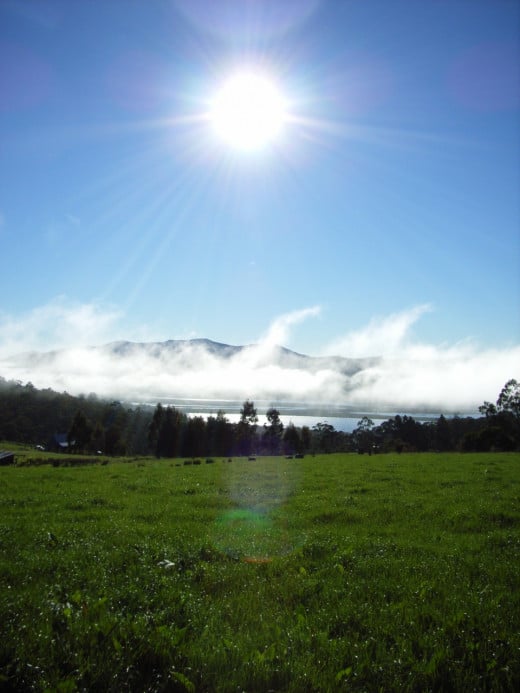
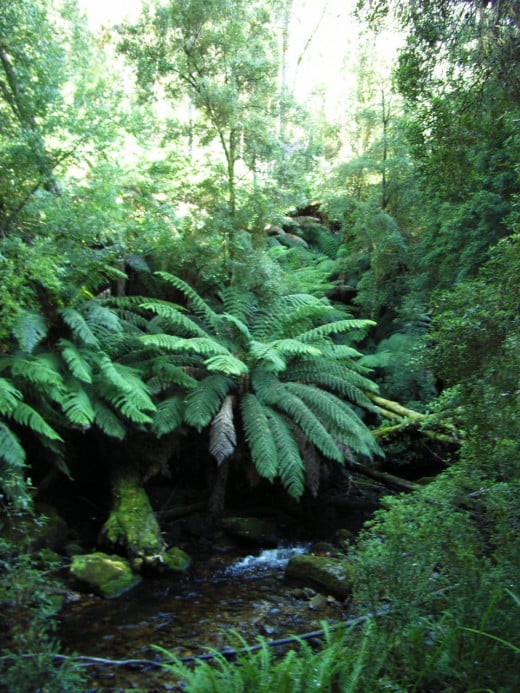
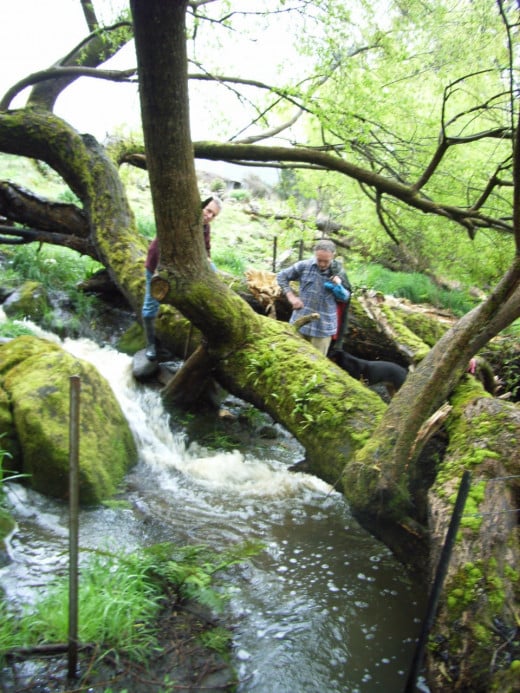
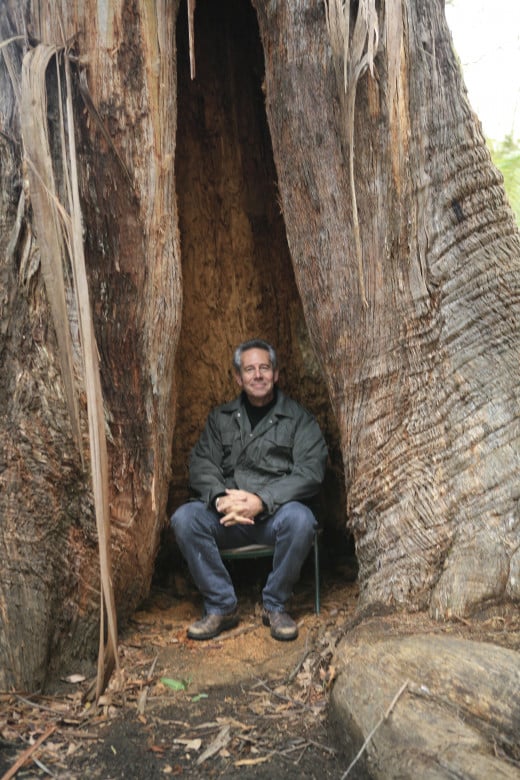
starting the vineyard
Rod had been a public servant and desk bound for 30 or more years, and I was also pretty much a city girl, so we had never done any real gardening. Removing years of rubbish and prickles looked daunting. We had no idea where, or how to start, but it all had to be done, and done quickly, as spring was quickly upon us and we had ordered 2,500 pinot noir clones, which would arrive in a few short weeks. They had to be planted as soon as they arrived. But how do you start planting out a huge paddock, edged with trees and turn it into a vineyard?
We had seen vineyards. They have nice long rows that face north. They have lots of poles in straight lines. They have lots of wires.
We decided that our first job should be to make straight rows in the paddock. Then we could ask Don, our next door neighbour, to come with his tractor and rip some lines where we wanted the grapes to grow, then get a rotary hoe operator in so we could plant in soft soil, then add some trellising, irrigation pipes and, hey-presto, we could plant the clones.
Yes, that seemed a good way to start. ‘We’ll make the lines’ said Rod. ‘It should be easy. It’s not rocket science.’
I knew that one day, we would sit and gaze out at our very own vineyard and sip our own wine and watch the rainbows. So, full of trust I obeyed everything Rod decided to do.
First we had to clear a paddock before we made the straight lines. We chose a spot near the house where we had a lovely hectare of north facing rich pasture. At the head of the future vineyard were about twenty huge, old gum trees and running down one side of the paddock were lots and lots of stringy, weedy poplars. The big old gum trees grew forty meters high and had dropped giant branches on the ground.
Arl, who knew all about trees said they had rotten hearts and could fall in a big wind. They were dangerous and were plantation trees. They weren’t native trees. The poplars took all the western sun and were about five to six meters high, but there were more than seventy of them.
We eyed those trees. They had to go. They would shade the vineyard and suck out the nutrients in the soil.
Rod went off to the mower and chainsaw repairman, who also sold every kind of farm cutting equipment ever invented. He returned with a chain saw, a hedge trimmer and a brush cutter. Boy-toys he called them.
He spent the evening reading the book on how to look after his toys and the following day he picked up the chain saw, fuelled it and eyed the stand of poplar trees. ‘Easy,’ he told me as he sauntered past, holding the chainsaw at a jaunty angle.
It only took him a few hours to demolish all the poplars. They fell across the paddock and lay in the long grass. Rod was so proud. ‘That was easy!’ he smiled.
But now we had tons of wood all over the paddock. Rod had to saw them into moveable size pieces so they could be lugged away and burned. This meant I had to help haul all the branches and trunks into piles while Rod cut up everything into moveable sized pieces.
That day we carried and dragged tons of wood. My back and arms ached and the long whippy branches caught in the grass and sprang back as they were dragged. By the time we cleared up the mess I was covered in bruises and we had a huge pile of wood ready for burning.
We were so exhausted with this work that at the end of the day, we fell asleep beside the fire at 8 p.m. When we woke up we went to bed at a fast run and dived under the doona and shivered ourselves asleep. Our muscles were so sore that when we turned over in our sleep the pain in our arms and legs woke us. I think I groaned every-time I moved.
Then as the big gum trees were, well big, we decided to leave them where they were and get on with dividing the paddock into long straight parallel lines so that Don could rip the soil. After measuring the paddock we decided we could have 19 rows of grapes, at 140 meters long, running due north and each line 2.8 meters wide and the trellis poles six meters apart. It looked lovely on paper.
We stepped the hectare block out several times and waved our arms around as we discussed how to do this geometry. While I was waving my arms, Don who was working in the apple orchard nearby waved cheerily back.
Rod decided the best way to mark the lines was to hammer wooden stakes in the ground. We would put a stake in about every ten meters on every line.
That sounded fairly sensible until we started. First, we had to get stakes. Luckily we found a lot of timber in the old pig shed that was down at the bottom of the garden. The wood was odd lengths, but each piece was about four centimetres square so it was perfect for stakes. Rod spent hours cutting the timber to length, cutting a sharp end and wheel-barrowing them all out to the field.
Then, with measuring tapes, we hammered our first stake into the ground. Then, every ten yards along one long line, at one edge of the field, we hammered in nineteen more. As soon as we finished we noticed the line sort of wobbled over the contours and it didn’t look straight. We pulled the stakes out and started again.
This time we paced out 19 lines spaced 2.8 meters wide and placed 19 sticks at the head row and using line of sight got them fairly straight. Then using string, we placed our next stick out into the paddock using a T-square in one corner, and so on, till we had made squares. Off we went, we measuring to each side, in front, making sure each line was 2.8 meters away from the other line, and keeping right angles as perfect as possible.
That day, we walked and back-tracked some fifteen kilometres and hammered hundreds of wooden stakes. By the time we finished, I discovered muscles in my arms and fingers I didn’t know existed. We often got very angry with each other because holding the tape straight between the stakes, and at a ninety degree angle, was time consuming and backbreaking and our fuses got shorter and shorter.
I had no idea there were so many little squares in a hectare of land. While we were working, we often looked up and saw Don in the apple orchard. Quite often he was scratching his head with a look of wonder in his eyes. We thought he was amazed at how clever we were at putting in our vineyard.
At last, we had a wonderful hectare of stakes! We stood back and admired our massive effort and all those lovely row of sticking up spikes. A big smile was still on our faces when the bull walked into the paddock with all his girlfriends and their calves. He walked up to the first stake and sniffed at it. Then he poked his bum up against it and rubbed some poo off his skin and knocked the stake down. All the other cows and calves thought this was a wonderful idea! By the end of the day they had pushed down all our pegs. No more lines!
We hadn’t thought about the cows. Of course, we hadn’t planned on fencing first. We didn’t know cows knocked things over. We just thought they sort of wandered around and ate grass. We stared at each other somewhat angrily. I firmly believed Rod should have thought of this before we started.
Don was in the apple orchard next door and saw us staring sadly at the ruined lines. The smile he had had on his face had broadened till it reached under his ears. He ambled over, obviously trying not to laugh. Then he gave us some farmer advice.
‘You should just have put one stake in at the end of the paddock then, using line of sight, run a big long string down to the other end,’ he advised. ‘Then you should spray the string with weed killer. In a day or so you’ll see your line and you can put in your next line so it is parallel. Also that’ll make it much easier for me to follow the spray lines with the ripper. If you stick with stakes you’ll have had to run ahead of me and remove the stakes as I drive. That’d make me slow, and it’ll be more expensive for you.’
So simple! Why didn’t we think of it? We also wondered why Don hadn’t told us to do this earlier. We suspected he enjoyed seeing us work in the city way. Us blow-in, city slickers know everything of course.
A few days later, we followed Don’s advice and finally we had a lovely cow proof, lines all ready for ripping and ploughing.
Puzzle solved.
But of course we had to fence the paddock sooner or later, so we decided to do it immediately. We got a wire spinner, kilometres of wire and a metal star picket ramming device called, a fencing dolly that weighs about 10 kilos, and loads of star pickets.
We began fencing. Rod started. He got a star picket. He held it in one hand and lifted the heavy fencing dolly over his head so that it would come down over the star picket. However, the dolly was heavier than he realised and it slipped from his grasp and hit him on the noggin. He dropped the star picket and it fell and hit him on the toe.
Blood poured from his head and he had to lie down very suddenly. Rod has a habit of fainting if he sees blood so it’s best if he lies down first. I raced for ice and towels, returned and lifted his feet till he recovered.
We worked out that you should put the dolly on the star picket and then lift them both into position together before you start ramming the dolly up and down to drive the star picket into the ground.
I even fenced. I lifted the dolly high. I rammed the dolly and soon I had quite a few star pickets in place. This was amazing exercise and I got huge upper arms and fat hands from all the muscle work. I even got rid of my ‘old lady bye byes’ under the arm. And we fenced the vineyard and installed two strands of electric fencing!
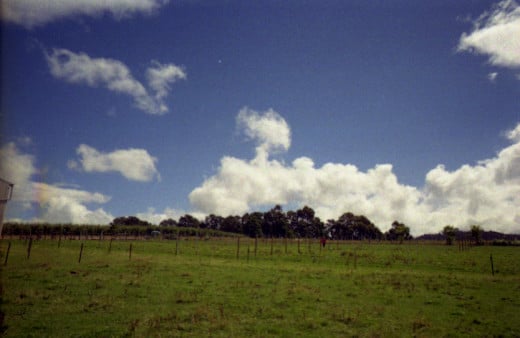
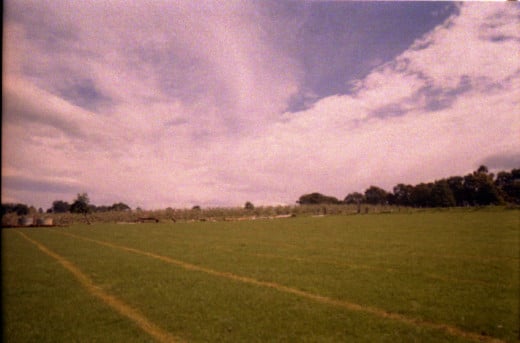
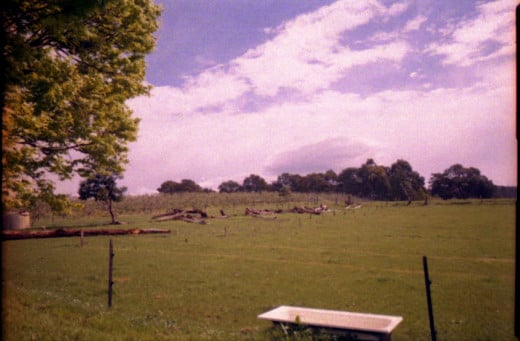
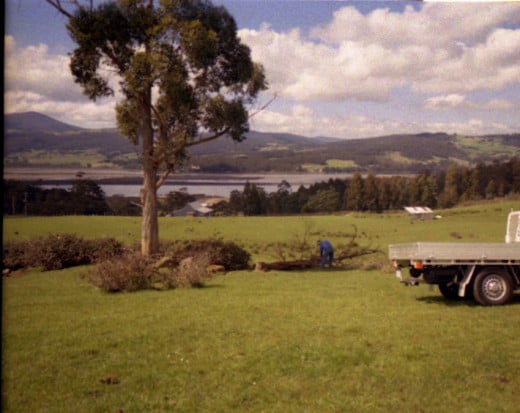
Getting ready to plant and several puzzling problems.
With the spring weather, we were becoming very busy. The vineyard couldn't wait any longer and we had to get it ready to plant the clones we had ordered. Rod and I also had to start getting rid of all the prickly things around the house so we could let the sun in the windows and keep ourselves a little warmer. We decided we’d work alternatively in the vineyard on one day and work another around the house on the other.
We made a start on the blackberries. Not only did they grow on all the boundary fences but also popped out from under the foundations of the house and hooked through every shed. They grew through the trees in front of the house to heights of 10 meters.
We paid Don to spray the boundary blackberries with the spray on his tractor. Later, when they died, we would burn them. Sadly, using the spray was not an option around the house. It would kill the lovely plants that had managed to survive amongst the strangling prickles that blocked out the light.
But where and how would we start? We decided after reading some books that we should find the base of the blackberry canes, cut them by hand, pull them out of the trees, drag them off and burn them. Then return and dab weed killer on the remnant stalks.
I clambered underneath some sweeping razor sharp thorns, beside the front of the house, on my hands and knees and made. With my trusty secateurs I cut my first blackberry cane right by the ground, (as described in the book) gripped a bramble with my gloved hands and pulled. The branches of the tree it was climbing over shook. I pulled harder. The leaves rattled on the roof of the house. But the bramble didn’t move. I didn’t give up. I strained harder, till I got out of the jungle and could stand. Then, prickly can in hand and pulling like a maniac and putting all my weight behind it, I gave it all I had.
Suddenly, the bramble let go. It flew out of the tree, whipped down and sprang round my neck. I fell back. The prickles stuck into me. Entrapped, I staggered to the fire and began extracting myself, pulling all the prickles from my clothes and yelping as the thorns cut my flesh. Luckily my gardening gloves stood up to the huge thorns. I couldn’t say the same for my wrists, neck and face.
After a week of work in the front garden I was too embarrassed to go out as I looked like I was into self-mutilation. But, I was winning. I could see the house and some mouldy, ancient rhododendrons.
Then there were scotch thistles. I spent two hours one morning giving the ones around the house a good dose of weed killer and then it rained and washed the weed killer off. So I had to start again a few days later. I tried not to be daunted with the thought that I only had sixteen acres more to go!
Then there were the briar roses! A whole quarter acre or more of them grew just below the pig shed. I set off with the new brush cutter and scythed my way through the worst of them, before Don informed me they would grow back and I had to poison them too.
But the worst prickle I received was when I went for a walk through the loveliest field of daffodils. These daffodils were growing wild, just out from the pig shed, (which was also over-grown with blackberries) and there I espied a bathtub by the boundary fence.
I went over and discovered the bathtub was full of water and it had a tap on one side of it. I turned the tap on and off and I could see that the water flowed out from a pipe that was rigged to Don’s dam and was connected to a toilet ballcock that allowed the bath to fill as needed. This flowing water was a bonus because we didn't have a dam on the property and this was where the cattle could drink, if Don ever took his cows home and we got our own. Don’s dam flowed out somewhere and ended up in Arl’s place somehow, but it could be years till we found the creek. Even then, cows would ruin a creek, so this would be our water source.
I was interested to know how the bath system worked and where the water came from, so I bent over and put my hand in the water and pulled out the plug from the bottom of the bath. Nothing happened because the plughole was blocked. I fetched a bit of wire and leant further over, put both hands in the water, and started unblocking the plughole.
Suddenly I felt very sick. A terrible juddering prickling shake went through my body and my head went all light and woozy. My bum hurt too. I managed to stand up and stagger away from the bath. It took me a few seconds before I realised I'd jammed by butt into the electric fence when I bent over. It was cunningly hidden behind some long grass.
So our days went on. Not only was it difficult to puzzle out how to do a vineyard, and do the thousand and one jobs we had ahead of us, but we also had to find our possessions. In general this shouldn’t have been a problem, but it was. We couldn't find anything we wanted because what we hadn’t sold was now inside plastic boxes.
We found ourselves spending a lot of time hunting through the kitchen cupboards for a saucepan or a cup, only to discover we didn’t own it any more because we’d sold it in our change-of-lifestyle garage sale back in Canberra.
But, one of the most intriguing puzzles of all was, we couldn't find one of Rod's sailing gumboots. We had one boot in with our shoes. It was an expensive, bright yellow boot and not difficult to spot. We hunted high and low for the other one, unpacking all our boxes till we finally resigned ourselves to the loss.
Then one morning we woke up and found the missing boot in the middle of the lounge room! How did it get there? It was a puzzle we never solved and it gave me a bit of a spooky feeling. I had a weird picture in my head of a one legged ghost clumping around the house in our boot and then returning it because it didn’t fit properly.
In fact, I began pondering about uni-pod ghosts or one-legged folk, and wondered why there weren’t more uni-pods living in our valley. Everyone around The House That Doesn’t Exist was addicted to mechanised tools and they used them without any safety equipment.
Every day I’d see the locals, hats pulled down, hacking or trimming, waving to you with toothless smiles as I drove past. (The dental system in Tasmania is appalling.) But, they all had arms and legs.
Rod was beginning to play with his brush cutter and his hedge trimmer, and he was bandying them about so dangerously, I was sure he was about to sever a limb. Those mechanised demons were really frightening.
In the midst of me worrying about life and limb and missing gumboots, we were unexpectedly given more mechanised life endangering horrors.
I have an Uncle, who was over seventy, bald and bored. He had lived most of his life in Tasmania and his kids had all moved to the mainland. He no longer had a wife. During his lifetime he had built several houses and boats and owned masses of tools. Just after we moved down, he developed a late-life crisis, sold up his home, bought a caravan and did the bald-nomad thing and disappeared to the mainland. As a parting gesture he kindly gave us all his tools.
There were buzz saws, circular saws, cross cut, band and jigsaws, compressors, generators, thicknessers, guns of every description, four nail guns and a ramset gun and they all looked very dangerous.
They were a fantastic gift but we hadn’t the faintest idea what half of some of these tools did, but we gratefully accepted them and stored them carefully in the barn as Rod returned to his favourite past time, chain-sawing.
After finishing with the poplar trees in the vineyard, he moved on to felling the smaller holly and hawthorn trees in the front garden. Every time they crashed to earth, dragging more blackberries with them, Rod seemed to grow taller and more confident. He moved onto a larger pine and a willow and felled them.
He got better at dodging the falling timber, but he often got his chainsaw stuck in the middle of the bigger trees. Watching him trying to remove the chainsaw as a large tree tottered over his head made me feel quite sick. My warnings seemed to have no effect on him. ‘Don’t worry!’ he’d yell, over the sound of the screaming chainsaw and flying sawdust. (The sound of the chainsaw was having a coup on his hearing and his intelligence.)
In fact I believed he was getting over confidant. I was right. One morning he sauntered into the barn and said. ‘I’m going to cut those gums in the vineyard down today. I’ll just sharpen the blades on the chainsaw and get to it.’ Despite my protestations, there was no stopping him. He was hell bent on felling the moribund monster blue gums.
So, not wishing Rod to become a uni-pod, or worse, I went inside and secretly rang Arl and told him of Rod’s plans.
Arl listened to my tale, sucked his breath in. ‘Don’t let him,’ he said. ‘Better still I’ll come up.’ He arrived before Rod had the chance to sharpen and re-grease the chainsaw’s blades.
Arl pretended he had called in for a coffee. While he was with us, he admired Rod’s work in the garden, but also explained that to remove the big trees in the vineyard, he needed to know a few tricks. He kindly offered to fell the trees for Rod while teaching him.
Rod accepted and they went to work. The trees were down in a matter of hours.
However, we now had tons and tons of massive tree trunks all over the vineyard. The puzzle was, how could we move them in time to plant the grapes? It would take a year to cut and move everything. We decided to work around them while we thought of a way to get rid of the wood. ‘Someone might want them for a fire,’ said Rod. ‘Perhaps they’ll come and remove them.’

